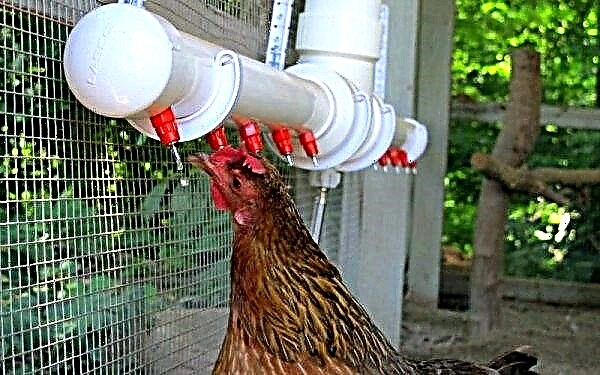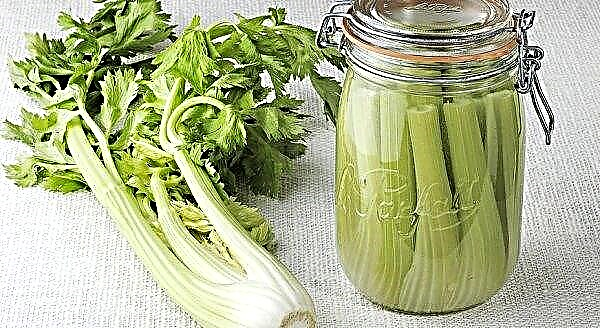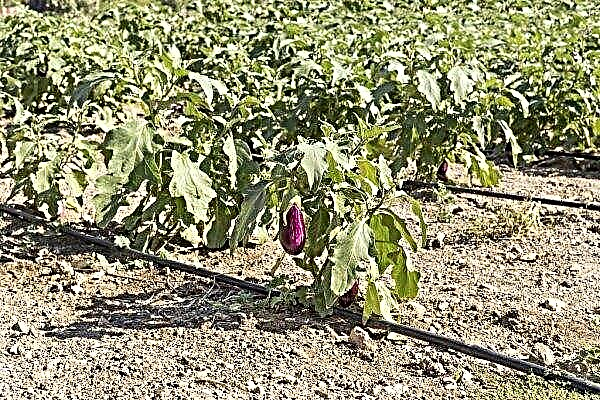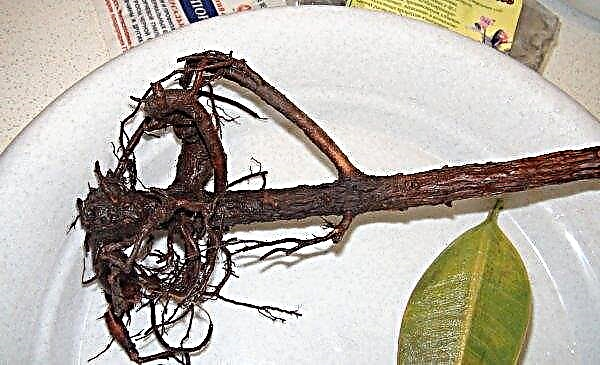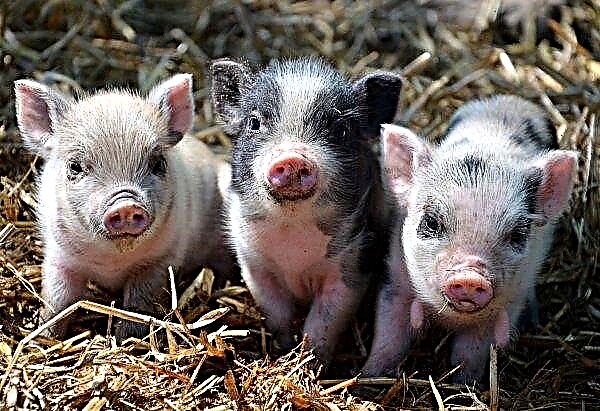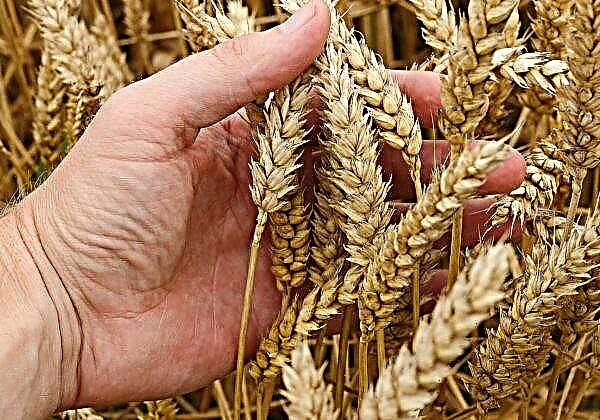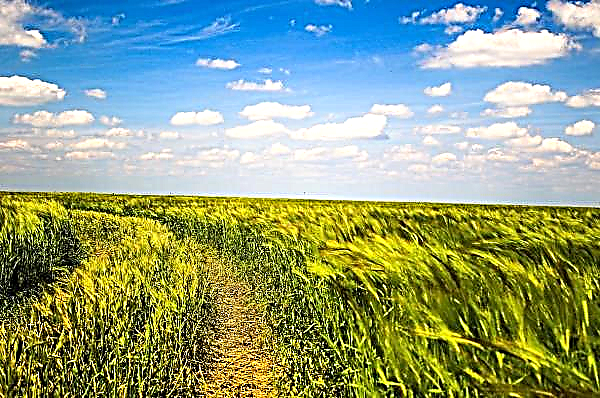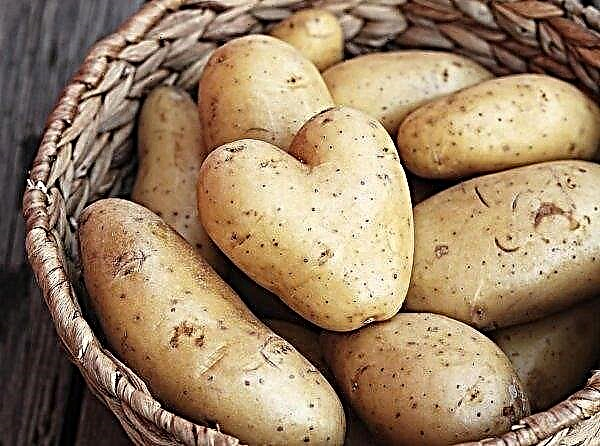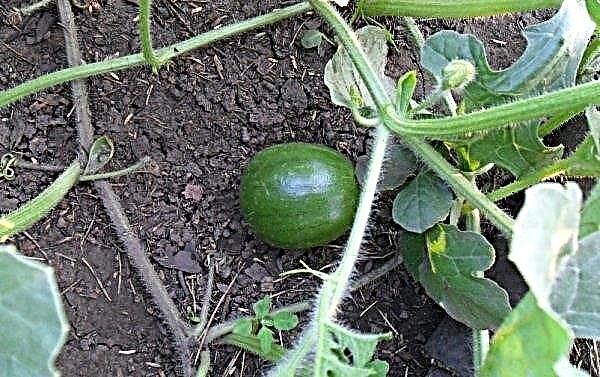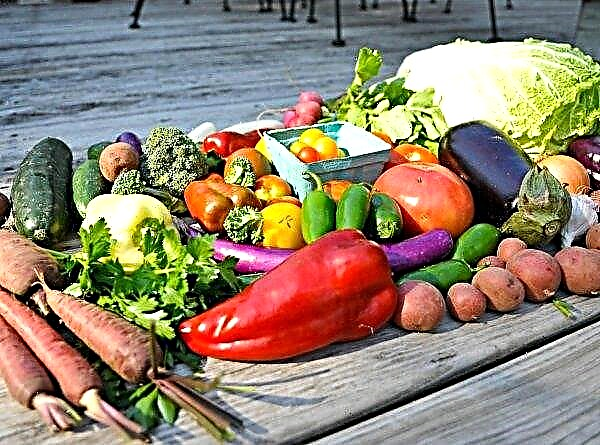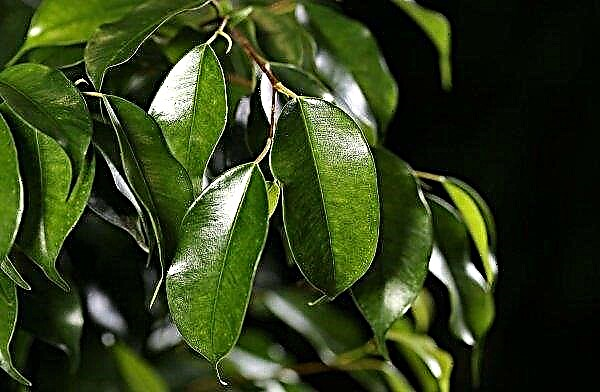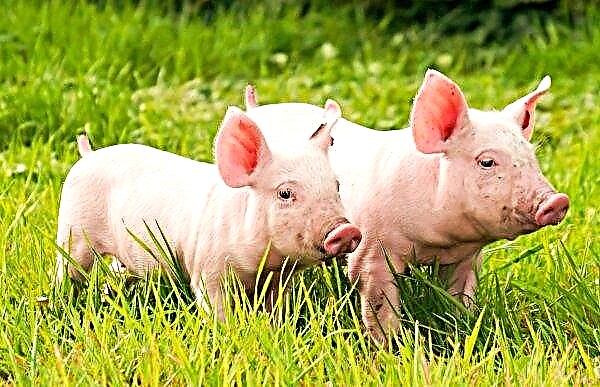To grow a good crop of onions is, of course, a pleasant event, but here a serious practical problem arises for the hostess: how to maintain supplies at least until the end of winter. This task is not particularly difficult in the presence of a cellar, but in a city apartment it seems almost impossible. How and what is best preserved onions, as well as some other tricks that a resident of an ordinary high-rise building needs to know in order to preserve the crop, is described in this review.
Harvest preparation for storage
In order for the onion to be stored as long as possible, it must be:
- completely ripe;
- dry
- absolutely healthy and intact;
- protected full layer of husk;
- clean (without clods of earth and dirt).
 In addition, it is advisable to take bulbs of the same shape and size for harvesting for the winter (ideally medium, as small and too large onions are stored worse), this will avoid the situation when some specimens begin to deteriorate, spreading the decomposition processes throughout the crop. With the "inventory" of the crop and the selection of suitable specimens for storage, usually there are no difficulties, you just need to remember about the need to carry out such work.
In addition, it is advisable to take bulbs of the same shape and size for harvesting for the winter (ideally medium, as small and too large onions are stored worse), this will avoid the situation when some specimens begin to deteriorate, spreading the decomposition processes throughout the crop. With the "inventory" of the crop and the selection of suitable specimens for storage, usually there are no difficulties, you just need to remember about the need to carry out such work.But to determine the degree of maturity of the crop and remove it at the right time is a whole art. The first and main sign of the readiness of the crop for harvesting is the massive drying and laying of horizontally above-ground parts of the plant (green feathers). Depending on the variety, this usually occurs 3-4 months after spring planting, that is, around August.
Important! Onions, intended for long-term storage, you need to try to clean in dry, sunny and windy weather. On heavy soil, the plant must first be dug up, otherwise there is a high probability of the bottom being left in the ground, such an onion will quickly rot.
If you dig a bulb during this period, you can make sure that it is already covered with a golden (white or red, if we are talking about the appropriate grade) protective husk, and the neck has become thin. However, it happens that the calendar harvest dates have already arrived, and the onion bed continues to turn green. In such a situation, the ripening of the onion should be “rushed”, otherwise you may not have time to properly prepare it for storage.
The various methods resorted to by gardeners cause an ambiguous attitude among scientists, for example, such options are practiced:
- cut off the aerial part of the plant completely (after such a procedure, most of the crop simply remains in the ground, so the option is far from the most successful);
- lower the tops to the ground and slightly push, making sure that it does not break completely;
- to undermine the roots with a shovel inserted under the plant at an obtuse angle;
- perform the same task by pulling the feathers a little, as if trying to raise the plant above the ground (another option is to bring the pitchfork to the root and slightly raise the entire earthen lump);
- carry out the procedure, the opposite of hilling - to scoop up the earth from the plant, slightly exposing it.
 The meaning in any case is that the plant ceases to receive nutrients from the earth, but at the same time send everything that has accumulated in the stem to complete the formation of the bulb. It is recommended that you leave the recovered onions for 1-2 days on a bed with dried tops, carefully carefully removing each copy from the ground (do this only with your hands, no shaking and tapping should be allowed, such movements can lead to mechanical damage to the delicate bulb).
The meaning in any case is that the plant ceases to receive nutrients from the earth, but at the same time send everything that has accumulated in the stem to complete the formation of the bulb. It is recommended that you leave the recovered onions for 1-2 days on a bed with dried tops, carefully carefully removing each copy from the ground (do this only with your hands, no shaking and tapping should be allowed, such movements can lead to mechanical damage to the delicate bulb).The next step is sorting. Unripe, diseased, substandard specimens are selected for immediate use, with the remaining part cut off the aerial part at a height of 4-5 cm from the neck (if the bow is planned to be stored in braids, pruning is performed above). The lower part of the bulb should also be processed - carefully cut off all the roots, in no case without damaging the bottom itself.
Important! Prematurely harvested onions due to the underdevelopment of the covering layer of the husk and the remaining open neck are easy prey for various pathogens, and therefore subject to rapid decay. In overripe specimens, the scales easily fall off, which also facilitates infection, in addition, such a bow often takes root and arrow, which means it is unsuitable for storage.
Which onion is best stored
Numerous varieties of onions differ from each other by different criteria, including keeping quality, that is, suitability for long-term storage. Therefore, when choosing a suitable variety for themselves, experienced summer residents always take this technical characteristic into account and, in addition to high-yielding and possessing the desired taste (spiciness or, on the contrary, sweetness) varieties, they must be planted that can be stored without any problems until spring.
In addition, you need to know that some varieties of onions with high frost resistance can be planted in the winter to get an earlier harvest, while others are only suitable for spring planting. At the same time, winter, as well as early ripe and mid-ripening varieties, as a general rule, should be consumed immediately after harvesting, and leave the latest onion for harvesting. From the point of view of useful properties, it is he who is the most valuable, since during ripening he manages to gain the maximum amount of vitamins, minerals and other biologically active substances that our body needs. And one more important rule: for storage, bulbs grown not from seeds, but from the so-called seeding - small heads with a diameter of 15-30 mm are better suited.
From the point of view of useful properties, it is he who is the most valuable, since during ripening he manages to gain the maximum amount of vitamins, minerals and other biologically active substances that our body needs. And one more important rule: for storage, bulbs grown not from seeds, but from the so-called seeding - small heads with a diameter of 15-30 mm are better suited.
Choosing a variety of onions to create stocks for the winter, you should pay attention to the following options:
| Spicy varieties | Arzamassky, Bessonovsky, Volsky, Skvirsky, Strigunovsky, Sturon, Centurion |
| Semisweet grades | Hercules, Danilovsky, Donetsk golden, Ermak, Karatalsky, Krasnodar, Lugansk, Samarkand, Stuttgart rizen |
| Violet and red varieties | Carmen, Campillo F1, Orion, Red Baron, Chalcedony, Yalta local |
| White varieties | Alba, Comet F1, Nevada, Snowball |
How to dry onions
Even the smallest onion variety will not be stored for long if it is laid out in boxes and sent to the cellar immediately after being removed from the ground, therefore, before harvesting in winter, the harvested crop must be dried very carefully.
Important! Yellow varieties of onions always have a better keeping quality than white and violet (red). Hot spicy onions are stored longer than sweet and semi-sharp.
Depending on weather conditions and summer resident’s capabilities, there are several ways to do this:
- Leave it directly on the ground so that each head is lit and warmed as best as possible. Such sunbaths will not only remove excess moisture from the upper flakes of the husk, but will also become an excellent natural disinfection for the bulbs. All that a gardener needs to do is turn heads from time to time so that “tanning” takes place evenly.
- Place under a canopy in a well-blown area - in the gazebo, on the open balcony, in the shade of the trees on a bed of waterproof material, etc. This method is used when harvesting is carried out in the fall, and the sun's rays can no longer actively warm the ground.
- Put in a makeshift "hammocks" from a mesh with a small mesh, equipped on a plot between trees, in the attic or on an open balcony. This method provides a much more effective blowing and drying, in addition, the bulbs in this case there is no need to turn over.
 In total, at least 7 days should be allocated for the drying time, but in cloudy and humid weather this procedure can take much longer. To make sure that the crop is ready for storage, you can hold your hands clasped between folded bulbs: if the hand passes easily, and the bulbs seem to part before an obstacle with a characteristic rustling, drying is over.
In total, at least 7 days should be allocated for the drying time, but in cloudy and humid weather this procedure can take much longer. To make sure that the crop is ready for storage, you can hold your hands clasped between folded bulbs: if the hand passes easily, and the bulbs seem to part before an obstacle with a characteristic rustling, drying is over.For additional control, experts advise trying to scroll the neck around its axis. A well-dried onion will break it. If the summer was cold, wet and rainy, it is recommended to wash and peel the upper layer of husk before drying. For 2-3 weeks in the open air, the onion is overgrown with one thin layer of young husk, which will give it a relatively good keeping quality.
Did you know? Onions, obviously, were very appreciated by the ancient Egyptians. Thus, information was preserved that one of the important costs during the construction of the Cheops pyramid was the purchase of onions for the slaves who built it, and in the tomb of Tutankhamun (estimated date of death - 1325 BC), an image was discovered that was well known to us bulbs.
There is also an express-drying method, which you can contact if none of the above methods is available (for example, there is no way to leave the harvested crop in the country, and the apartment does not have an open balcony). In this situation, it is recommended to use an oven. Warming it up to + 40 ... + 45 ° C, put a baking sheet with the onions laid on it, leave the oven door ajar and thus warm the crop for 12 hours with periodic stirring.
Ways to keep onions in the apartment
Once the onion suitable for harvesting is selected and dried, you can proceed to the most important thing - laying the crop for long-term storage. There are several ways to do this.
Where to store
The first thing to decide is the choice of a suitable container. The main requirement that is presented to it is that the material must “breathe”, otherwise putrefactive processes in the fruits will begin to proceed very quickly. Having immediately excluded glass and monolithic plastic for this reason, we will consider more successful options.
Important! For additional disinfection and absorption of possible condensate during the laying of onions in boxes or boxes, it is recommended to sprinkle onions with chopped charcoal or crushed chalk in an amount of about 200 g of powder per 10 kg of vegetables.
In drawers
Wooden crates are perfect for the task, since they initially have gaps between the boards, which are used for natural ventilation. The width of such slots should be at least 10-15 mm, otherwise, artificial vents must be made in the bottom. Boxes made of plastic perform this function a little worse. Although they can also be used if the sides and bottom of the container are made in the form of a grid with a small cell. The thinner the onion layer will be in the tank, the better (the maximum permissible indicator is 40 cm), so it is best to choose the drawers low and then stack them on top of each other.
Although they can also be used if the sides and bottom of the container are made in the form of a grid with a small cell. The thinner the onion layer will be in the tank, the better (the maximum permissible indicator is 40 cm), so it is best to choose the drawers low and then stack them on top of each other.
Did you know? In Russia, onions were prepared for storage by the method of smoking, for which peasant baths were often used. The procedure lasted from two to three days and provided excellent crop disinfection by combustion products, and also blocked its subsequent germination, which ultimately increased the onion shelf life by at least one and a half to two months.
In cardboard boxes
Cardboard is a good natural material for storing vegetables, but there are no ready-made holes in such boxes, so you need to make them yourself in the bottom and on the sides. Otherwise, the requirements for the size of the container and the placement of the crop in it are similar to those described above. A suitable microclimate in the box will also help create dry herbs (best nettle) or pre-dried onion husks. In the absence of cardboard boxes, onions can also be stored in ordinary paper bags, although from a practical point of view this option is still not very convenient, since paper, even thick, under the weight of the vegetables placed in it, can burst at any time.
In the absence of cardboard boxes, onions can also be stored in ordinary paper bags, although from a practical point of view this option is still not very convenient, since paper, even thick, under the weight of the vegetables placed in it, can burst at any time.
Important! Potatoes, beets and carrots are better stored in cool and humid conditions, but onions require dryness, so an experienced hostess will never put such preparations next to them.
In the baskets of vines
If the hostess has such a container, it must be used. It is made from natural raw materials, has low thermal conductivity and is well ventilated. And besides everything else, stocks stacked in such containers look much more aesthetic than boxes and boxes, which is also important for a city apartment. It should only be remembered that baskets should not be selected very large, with the expectation that in each of them no more than 8-10 kg of onions were placed. The optimal volume of containers is 5-6 liters.
In fabric bags
Flax, cotton, jute, hemp, rope, kenaf and other natural materials as the basis of the fabric for making bags make them an excellent packaging material that allows you to store vegetables in it, including onions for a long time. As in the case of baskets, the bags are best sewn small, so you can significantly increase the performance indicators.
In polyethylene nets
Onions are often transported and sold in special vegetable mesh bags. They are made of various polymeric materials, most often polypropylene yarn. The advantage of such packaging is its high strength, durability, practicality, low cost, good ventilation, as well as the visual availability of the goods in it.
Did you know? The largest bulb in the world (diameter 81 cm, weight 8.49 kg), which fell into the Guinness Book of Records, in 2014 was raised by an Englishman named Tony Glover. The greatest surprise in this story is that Tony's main profession is not farming at all, but ... making billiard balls.
According to these indicators, vegetable nets may well be used for long-term storage of onions, however, it is preferable to choose the minimum size calculated for 5 kg of vegetables from the entire assortment. The standard sizes of such a bag are 25x30 cm. Some housewives store stocks of onions in old nylon tights or stockings in the old way.
Oddly enough, such a method has a right to exist and, in general, is in no way inferior to a polypropylene or polyethylene mesh. Finally, it is worth mentioning another traditional way of harvesting onions for the winter - braids and wreaths, during the weaving of which, in addition to the plant’s own tops, straw stems, thin twine or yarn are used for greater strength. In addition to good ventilation and minimizing the risk of condensation, this option, unlike all of the above, can be considered as a very stylish decoration of the room - pantry or kitchen. Another advantage of the braid is that it is very convenient to use: if necessary, you can easily select and cut the onion that you like, while you have to untie the bags, open the boxes, and after extracting the right amount of vegetables from them, carry out the reverse packing procedure .
In addition to good ventilation and minimizing the risk of condensation, this option, unlike all of the above, can be considered as a very stylish decoration of the room - pantry or kitchen. Another advantage of the braid is that it is very convenient to use: if necessary, you can easily select and cut the onion that you like, while you have to untie the bags, open the boxes, and after extracting the right amount of vegetables from them, carry out the reverse packing procedure .
Storage conditions
Regardless of which onion storage container was chosen, the crop must be preserved under strictly defined conditions, the main of which are coolness, dryness, lack of bright light (onions are not so prone to germination in the dark) and good ventilation.
The microclimate in the room where the onion is stored must meet the following requirements:
| Optimum temperature | -1 ° C |
| Minimum allowable temperature | 0 ... + 3 ° C |
| Maximum allowable temperature | + 4 ° C |
| Maximum Humidity | 75–80% |
In the refrigerator, onions can be stored only for the shortest time, for long-term harvesting there is no important condition here - air circulation.
How to store onions in winter - on the balcony or in the cellar
Oddly enough, a cellar for winter storage of onions is not the best option. For owners of private houses for this purpose it is better to use an attic or dry basement, where the humidity is much lower, or resort to additional tricks, for example, to place containers filled with sawdust or other material in the immediate vicinity of boxes or boxes with onions that can absorb excess moisture.
In a city apartment, rooms with room temperature (cabinets or pantries) can be used for storing onions, but unheated but glazed loggias are better for these purposes. It is undesirable to store vegetables on open balconies or verandas: it is too wet in the fall and cold in the winter. If the temperature on the closed balcony can drop below the critical indicator indicated in the table, experienced housewives pre-try to insulate boxes or boxes with onions by laying an additional layer of heat-insulating material, for example, polystyrene foam, on top, bottom and sides. The same role, however, can play an old cotton blanket.
If the temperature on the closed balcony can drop below the critical indicator indicated in the table, experienced housewives pre-try to insulate boxes or boxes with onions by laying an additional layer of heat-insulating material, for example, polystyrene foam, on top, bottom and sides. The same role, however, can play an old cotton blanket.
However, packaging insulation must still be treated with great caution, because in the heat and limited air supply, vegetables begin to produce condensate, and this, in turn, stimulates the pathogenic microflora and starts rotting processes. When storing onions in a heated room, you need to understand that such conditions greatly reduce the time during which the vegetable can remain usable, and also slightly reduce its quality.
Under any circumstances, the cooler the air in the room, the better. Finally, to increase the shelf life of the crop, experts advise that it be regularly inspected. To do this, at least once a month, boxes or boxes should be brought into the house, opened and sorted, removing all copies that show at least slight signs of damage (it is not necessary to throw them away, just put them in the refrigerator and put into use as soon as possible) . Storage of onions is a time consuming and responsible process. Perhaps the main key to success in this case is the right choice of raw materials and its thorough preliminary preparation. But having done all these measures, one should not forget about the stocks for a long time, only in this way it is possible to prevent the beginning of the putrefactive process and save most of the crop from quick spoilage.
Storage of onions is a time consuming and responsible process. Perhaps the main key to success in this case is the right choice of raw materials and its thorough preliminary preparation. But having done all these measures, one should not forget about the stocks for a long time, only in this way it is possible to prevent the beginning of the putrefactive process and save most of the crop from quick spoilage.

